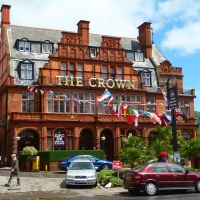Tales from the Terminals: Euston. Part One (1830s Euston)
Continuing our journey through London’s numerous railway terminals, we now reach Euston; a station which has experienced its fair share of problems and controversy over the years.
Despite its current, modern appearance, Euston Station is in fact the oldest of London’s inter-city terminals, tracing its roots all the way back to 1837.
Euston takes its name from a small village in Suffolk, which dates back to at least 1086 when it was recorded in the Domesday Book as ‘Eustana’. In this peaceful village, you will find ‘Euston Hall’ which has been home to the Dukes of Grafton for hundreds of years.

Euston Hall, Suffolk
In 1817, Euston Square, named after the Duke of Grafton’s seat, was built. The station followed a few years later, constructed around the same area.
*
The First Euston Station
Today, trains from Euston travel great distances. Some- including the overnight Caledonian Sleeper which departs late from Euston six evenings a week- run as far as Inverness in the Scottish Highlands (a far longer journey than London’s St Pancras to Paris!)
However, the original line in and out of Euston was far shorter; first envisioned as a railway linking London to Birmingham. Christened ‘The London and Birmingham Railway’, the project did exactly what it said on the tin.
The London and Birmingham Railway, along with Euston Station, was masterminded by Robert Stephenson- son of railway pioneer, George Stephenson; the genius engineer who achieved many ground-breaking railway firsts- the most notable being the construction of the world’s first passenger line between Liverpool and Manchester, which began conveying the public in 1830.
As a young man, Robert had assisted his father in such projects, and was therefore blessed with a sound knowledge of the burgeoning Victorian technology.

George and Robert Stephenson
Planning for the railway began in the autumn of 1830; the cost of the project being estimated at £3,000,000.
When first planned, the London terminal was to be built at Chalk Farm (just outside Camden Town, and approximately 1 mile north of where the current station exists).
Some work was carried out at Chalk Farm for this purpose; in the vicinity behind what is now ‘Camden Roundhouse’ and, to this day, a siding on this site is still officially labelled as ‘The Terminus Siding’. The Roundhouse itself was built in 1847 to house a railway turntable. Today, the circular building is a popular performing arts venue.

Camden Roundhouse
In 1835, permission was granted to take the line a little further south. The Chalk Farm plans were abandoned, and the new terminal building was earmarked for a peaceful clearing called ‘Euston Grove’; a patch of land which belonged to Rhodes Farm. As mentioned earlier, the relatively new ‘Euston Square’ also existed in this locale.
*
When Euston Station first opened, it was a very simple affair with just two platforms; one for departures and one for arrivals.

Euston Station, 1837
In 1837, steam engines and railway tracks were still pretty much a novelty, and only six trains per day ran out to destinations as far flung as Harrow, Watford and Boxmoor (now part of Hemel Hempstead).
Blood, Sweat and Tears
Despite humble beginnings, it took just over a year for the railway’s builders to thrash out over a hundred more miles of track, reaching the ultimate destination of Birmingham and thus linking London to England’s second city which, in those days, was also one of the British Empire’s most important powerhouses.
The men who forged these routes were known as ‘Navvies’; a term originating from the word ‘navigator’, first given to the builders who had dug Britain’s canal network several decades before.

A Victorian depiction of a Navvy, from ‘Punch’ magazine
The Navvies, who came from all corners of the United Kingdom, were ferociously hard workers with a reputation for drinking as hard as they toiled.

The cutting at Tring (Hertfordshire) under construction in 1837
As they built the railway, the Navvies tended to form themselves into work-gangs; groups of pals who worked, lived and drank together. These gangs camped on site, their itinerant lifestyle allowing them to follow the progression of the project on which they were employed.
Conditions were harsh to say the least.
Apart from the dangerous nature of the work (‘health and safety’ in those days being non-existent), these early railway pioneers were subjected to frequent outbreaks of cholera and typhoid; diseases which struck thanks to the unsanitary conditions in which they lived and worked.
The stressful work, hard boozing and frequent gambling resulted in many quarrels and fist-fights- some so severe that, on several occasions, the army were required to ride in and put a stop to the bad behaviour!
We don’t serve your kind here…
In the area around Camden and Euston, where extensive building work on the new railway was required, the pubs in which the men drank were segregated in order to prevent nationalistic quarrels and brawling.
The four main pubs were therefore named after castles located in each part of the UK, so each worker would know where he was welcome, and where he would find his fellow countrymen.
Today, all but one of the taverns are still going strong and are well worth a visit- and don’t worry, the jingoistic divisions are no longer enforced!
Here is a quick guide to them:
The Edinboro’ Castle
As the name suggests- even though it is curiously spelt incorrectly- this pub is where the Scottish workers came for a wee dram. The pub is perched high over the railway tracks, on the main approach into Euston. Today, the Edinboro Castle is a tempting gastro pub, especially popular during the summer thanks to its large beer garden.
The Pembroke Castle
Built for the Welsh gangers, The Pembroke Castle also backs right onto the railway line, and is a short walk from Camden Roundhouse. Today, it is well known for The Hampstead Comedy Club which hosts regular stand-up evenings.
The Warwick Castle
Sadly, this pub, which provided the English builders with ale, no longer exists. Until recently, it was known as the NW1 Bar, but is now closed and appears to be undergoing renovation (for a café apparently).
The Dublin Castle
Located on Parkway in Camden, the Dublin Castle was where the Irish navvies sank their wages. Today, this pub is a legendary music venue where, over the years, bands such as Blur, Supergrass and, most famously, quintessential London group, Madness have forged their careers.
In 1979, Madness filmed the video for their song, My Girl at the Dublin Castle (the Irish gentleman seen at the beginning of the clip is Alo Conlon. He was indeed the pub’s real landlord and was a Camden legend. Alo sadly died in 2009. You can read more about him here).
*
An Uphill Struggle
Nowadays (assuming there are no leaves on the line of course), London to Birmingham by train can be achieved in about 90 minutes.
However, in 1838 when the service was first initiated, London to Birmingham on an old, puffing steam train was an ordeal which took over five hours…. five hours that is, assuming the train could actually make it out of the station!
Euston lies at the bottom of a steep incline and, for the first few years of service, this proved problematic as early steam engines simply weren’t powerful enough to haul their loads up the slope.
To overcome this obstacle, trains departing Euston therefore had to be attached to a long cable which stretched some 4,370 metres, all the way up to Camden Town.
At the Camden end, the ropes were linked to and driven by a pair of large, stationary, 60-horsepower engines; a set-up which enabled north-bound trains to be literally dragged away from Euston.

Chimneys belonging to the powerful ‘dragging’ engines which were at Camden Town
Incoming trains however used the slope to their advantage; allowing gravity, and the expertise of an experienced brakeman, to roll the carriages down to the arrivals platform. This novel process continued until 1844.
*
Victorian Grandeur
Over the next few years, building and expansion continued at Euston; the station soon being transformed into a grand and celebrated London landmark.
The most famous aspect of the burgeoning terminal was the iconic ‘Doric Arch.’

The Doric Arch… with an early rank of horse-drawn taxis!
The Doric Arch was erected in 1838, at a cost of £35,000; a stratospheric sum for the time. The architect of the centrepiece was Phillip Hardwick; an engineer who had also worked on Liverpool’s Albert Dock.
This extravagance was justified to shareholders in a report stating;
“The entrance to the London passenger station… opening immediately upon what will necessarily become the Grand Avenue for travelling between the Midland and Northern parts of the Kingdom, the directors thought that is should receive some embellishment.”
Other additions to the station included the ‘Great Hall’, which was opened in 1849. This huge hall, which doubled as Euston’s main concourse and waiting area, was a grand affair indeed.
Built in the Roman-Ionic style, the hall was long, wide and boasted a towering roof, standing 19 metres above the ground. On the hall’s opening day, a newspaper reported that Euston, “as a railway station, is without equal.”
Alongside this grandeur, two hotels were also added; The Euston, which was stately and expensive, and The Victoria, which was far cheaper; offering dormitory style accommodation.
*
Sadly, this grandiosity faded during the first half of the 20th Century.
By the 1930s, increased routes and usage had resulted in Euston becoming cramped and unfit for purpose
In response to this, the London Midland and Scottish Railway Company sought a complete rebuild of the station, and consulted Welsh architect, Percy Thomas to come up with a design. The suggested blue-print was a bold, classic affair, largely inspired by modern American architecture:

The Euston that never was… a shelved 1930s plan
However, shortly after the design was put forward, WWII broke out and the plan was dropped, never to see fruition.
*
Tragedy on the Euston Line
A few years after the War, on the morning of 8th October 1952, the tracks running into Euston witnessed the worst civilian rail crash in British history.
The disaster took place at Harrow and Wealdstone Station, 15 minutes outside of Euston and one of the London terminal’s earliest destinations when first opened in the 1830s.
The accident, which took place in heavy fog, involved three trains.
A local, commuter train, was stationary at Harrow and Wealdstone when it was struck by a speeding express; the overnight sleeper train which was travelling from Perth in Scotland, to Euston. It appeared that, due to the thick fog, the sleeper train’s driver had failed to notice a signal set at danger.
Moments after the collision, a third train; another express- this one travelling from Euston to Manchester- ploughed into the steaming wreckage.
The debris from the triple crash was scattered across all six tracks and platforms. Part of the station’s footbridge was also ripped down.
Many were trapped in the tangled mess and the resulting recovery took several days. Overall, 112 people died and 340 were badly injured. 39 of the dead were Euston station employees; killed on the local commuter train as they made their way into work.
The death toll would have been even higher had it not been for the involvement of 150 American Air Force personnel. Shortly after news of the major crash was received, the Americans (based at nearby Ruislip) rushed to the scene.
The sheer level of destruction and injury resembled a battle field, leading the Americans to instinctively set up what was essentially a field hospital.
The consequent blood and plasma transfusions, conducted in improvised conditions amongst the devastation, saved many lives.
In the unit drafted in to assist, there was only one female; a 31 year old nurse from Florida called Abbie Sweetwine.
One of the only black, American women serving in the USAF at the time, Abbie administered first aid to many, as well as providing much tea and comfort. She also had the grim task of marking patient’s heads with symbols related to how severe their injuries were and if any treatment had been received. For this, she had to improvise… and used a tube of red lipstick.
So comforting was her presence, that survivors of the disaster nicknamed Abbie the ‘Angel of Platform Six.’ Several months after the disaster, she was honoured by the Royal Variety Club and given a silver cigarette case with her nickname engraved upon it.
Abbie Sweetwine can be briefly glimpsed (around the 1:10 mark) in the following newsreel from the time:

















